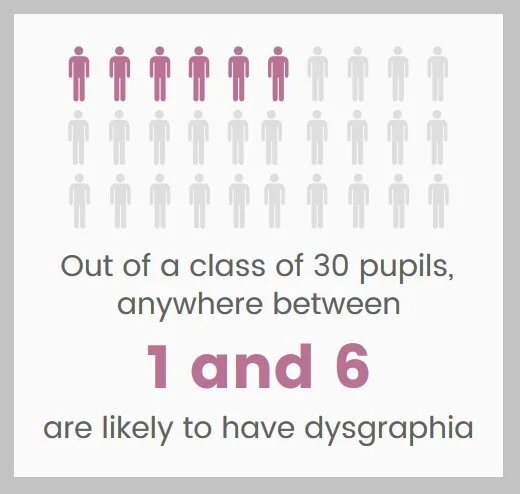What Is Dysgraphia?
by Rebekah Kuschmider
Pretty much everyone has heard of dyslexia. But have you heard of dysgraphia?
No, it's not a problem with reading graphs. Dysgraphia is a neurological issue that makes writing incredibly difficult. It affects the fine motor skills needed for handwriting as well as the organizational thinking necessary for written communication.
It's also more common than you think. There are estimates that as many as 5-20% of people have some deficits associated with dysgraphia.
With numbers like that, we might already know someone with dysgraphia. So understanding it can help us understand them, and de-stigmatize this little-known learning difference.
What dysgraphia looks like.
The biggest indicator of dysgraphia is illegible handwriting.
We’re not talking about typical sloppy writing, or hurried scribble. People with dysgraphia have handwriting that can't really be read. Even they struggle to decipher what they wrote. It doesn't matter if it's a lot of writing or a little. Simply filling out a form can be difficult for people with dysgraphia.
This is because dysgraphia affects fine motor skills, so the physical act of writing is compromised. People with dysgraphia might have a strange way of holding a pen or fork. They might have trouble fastening buttons or cutting food.
The handwriting problems go beyond the shape and form of letters, too. Some people have spatial planning difficulties, so their words end up oddly sized and poorly spaced on the page. They have the same problem getting a drawing to fit on paper. The spatial reasoning challenges mean some people with dysgraphia are not able to read maps.
Dysgraphia might make it challenging to remember written grammar rules, like punctuation, capitalization, and paragraph breaks. It also affects the thought process for organizing writing. A student with dysgraphia may know all the relevant material for a written assignment but can't put the pieces together into a coherent essay. Adults with dysgraphia may struggle to compose an email or text message.
If that sounds frustrating, that's because it is. Experts will tell you that people who have dysgraphia feel immense anxiety around writing anything. There's a lot of aggravation of not being able to express themselves in writing. They might also feel confused and depressed about not being able to do something that is considered so important.
What is dysgraphia NOT?
First of all, we should be perfectly clear that dysgraphia is not an indication of low intelligence. It’s time to do away with this persistent myth that learning differences reflect intelligence. In reality, they are differences in how a person best absorbs new information or skills.
Secondly, dysgraphia isn't a reading disability. It sounds like dyslexia but they're actually very different. Dyslexia is a decoding problem. The symbols that make up letters and words don't compute typically for folks with dyslexia. They might have trouble associating letters with the sounds they make. Dyslexia causes writing difficulties because the fundamental elements of written language are the obstacle.
Dysgraphia, by contrast, affects getting information out of the brain, not into the brain, making it a transcription problem. A person with dysgraphia can learn all the pertinent information but they have difficulty putting their thoughts on paper.
Finally, dysgraphia is not temporary. People don't "outgrow" it. This is the way their brains work.
Because dysgraphia is a lifelong condition, people need to learn lifelong skills for understanding and managing it.
How is it diagnosed?
Parents and teachers usually start to suspect dysgraphia when a student reaches second grade and still shows certain writing deficits. It's not unusual for early learners to have writing that's all over the place. But if the illegible writing, unusual placement, and trouble with sentence structures continue after second grade, it might be a sign that the child has dysgraphia.
Unfortunately, it's possible to make it all the way to adulthood with undiagnosed dysgraphia because it’s so commonly overlooked or misdiagnosed. Terrible handwriting can be dismissed as laziness. Trouble with writing might be mistaken for ADHD or a reading comprehension problem.
Also, a professional has to be the one to diagnose it. A psychologist with a background in learning disabilities can look at school reports, work history, and medical records. She'll take a detailed history about how long you have had trouble with writing. There are evaluations she can perform to analyze what happens when you try to write by hand or on a keyboard. From there, she'll determine a diagnosis.
Interestingly, dysgraphia isn't a stand-alone diagnosis. That's because the Diagnostic and Statistical Manual of Mental Disorders 5th Edition (DSM-5) doesn't list dysgraphia as a discrete learning disorder. Instead, the classification is Specific Learning Disorder or SLD. To be more specific, they might call it "SLD with impairment in written expression."
As vague as that sounds, it's precisely the phrase you need to know to ask for accommodations. People with learning disabilities are entitled to protections in school and at work.
What can you do if you have dysgraphia?
Dysgraphia affects motor skills and spatial relations more than cognitive abilities, which is why traditional academic tutoring probably isn't the right approach for this learning difference.
Instead, people with dysgraphia— both children and adults, alike— can benefit from occupational therapy. Occupational therapists (OT) are skilled at assessing the reasons for handwriting issues as well as working with them to improve these skills.
The OT might suggest physical aids like special pencil grips, textured paper, or special desk set-ups. She might be able to help handle tasks like filling out forms or addressing mail, which can be a source of stress for people with dysgraphia.
Technology is also an asset. Think of the advances in speech-to-text apps over the past five years. Those apps, which are embedded in many phones and computers, let a person with dysgraphia get their thoughts on paper — or in an email or text— without ever lifting a pen.
Adults who have difficulty writing with a pen can find that using a keyboard is much easier. Typing corrects the spatial planning element of writing automatically. Apps to improve typing skills are available for free and can help kids and adults hone their typing to make it faster and more accurate.
For kids and adults who need to do written projects at school or work, they can use a number of strategies to help with organizing their work.
These include:
Using voice-to-text apps.
Using graphic organizers to plot out longer writing assignments, which can be customized online.
Using color-coded index cards to organize information.
Giving themselves plenty of time to work on the project before the deadline.
Asking someone at work or school to help proofread and edit work before submitting it.
Using online spelling and grammar checkers.
Oh, and if your dysgraphia means you can't read a map? That's what GPS was invented for. Don't sweat it.
Supporting people with dysgraphia.
A learning difference is only one part a person. All people have strengths and weaknesses. All people have to work harder at some things, but find other things easy. Knowing our own abilities and planning how much time and effort we need for different things is part of life for everyone.
Learning about dysgraphia and gathering a toolbox of skills to help cope with it is something people can do, no matter what age they are when they get a diagnosis. Learning is lifelong and so is adapting to learning differences.
And adults who understand dysgraphia can do their part by explaining it to other people. The more we know and discuss learning differences, the more we can all accept our own differences without shame.



